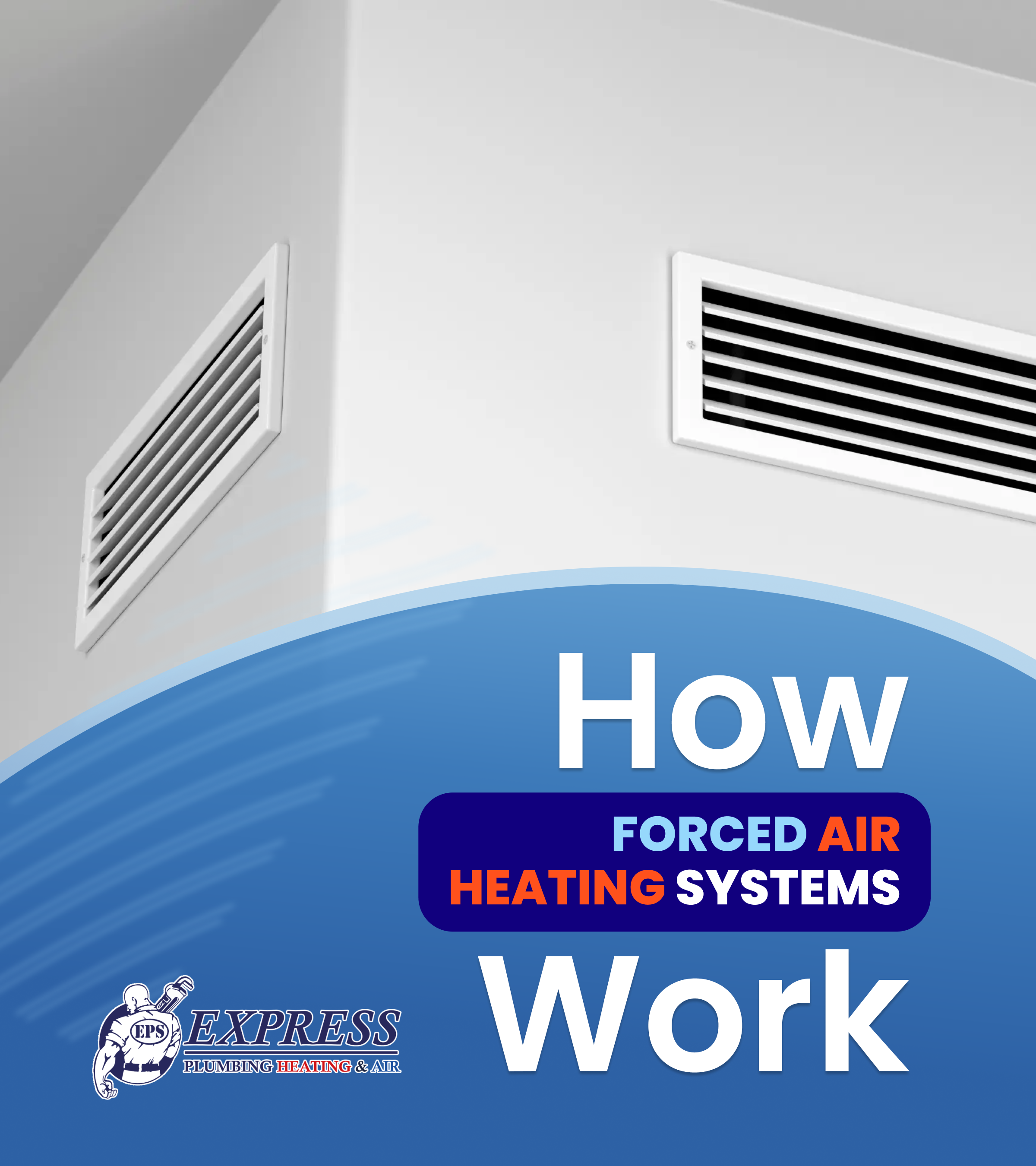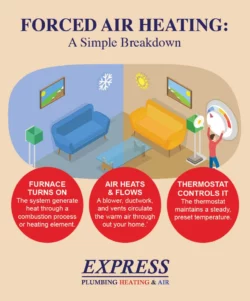Forced air heating systems push conditioned air through an HVAC system via a blower after it’s heated by a furnace or cooled by an air conditioner. It’s a beneficial system commonly used in homes throughout Idaho because it provides quick and efficient heating. It’s also compatible with central air conditioning, allowing you to adjust your home to a comfortable temperature year-round.
As a homeowner, it’s important to understand how your forced air system works to make informed decisions about maintenance and repairs. If you’re interested in learning how your system operates or want to schedule a repair or tune-up, the experienced team at Express Plumbing, Heating, & Air can help.
What Is a Forced Air Heating System?
Forced air heating is best explained as a home heating system that uses a fan, ductwork, and ventilation system to efficiently deliver heat and cooled air to every room in your home. This differs from other heating systems like radiant heating or boilers because the conditioned air is pushed through the space, heating or cooling the room faster than other types of heaters.
Key components of a forced air heating system
The key components of a forced air HVAC system include:
- The furnace: The furnace generates heat using gas, electricity, or oil.
- The blower motor: The blower motor distributes the heated air through the ductwork, pulling air from a room, heating or cooling it, then pushing it back into your home.
- Ductwork and vents: This is the pathway for the warm air to travel throughout the home.
- The thermostat: The thermostat controls the system by sensing the ambient temperature and then switching the furnace and AC on or off to achieve your desired home temperature.
- The air filter: The air filter captures dust, allergens, and other particulates before the air circulates through your house.
How Does a Forced Air Heating System Work?
Your central heating system has several components working together to achieve whole-home comfort.
1. The heating process begins
Depending on the type of furnace, it uses a pilot light or electronic ignition system to start the heating process. Gas and oil furnaces burn fuel and use a metal heat exchanger to transfer heat from the combustion process, while electric furnaces have electric heating elements.
2. Air circulation and distribution
After the furnace turns on and gets hot, the blower motor powers a fan that circulates cool air through the system. It draws air from the rooms into the ductwork and through the furnace’s heat exchanger, where it’s heated up and forced back into the ducts and through supply vents by the blower.
3. Maintaining temperature and efficiency
The thermostat in your home is hardwired to communicate with your HVAC system. It uses a temperature sensor to determine when to turn the system on or off to maintain a steady, comfortable temperature. Return ducts recirculate the air back into your furnace.
Types of Forced Air Heating Systems
There are different types of forced air heating systems to choose from.
Gas vs. electric vs. oil furnaces
A gas furnace is the most common and cost-effective option, using natural gas or propane to heat your home. Electric furnaces use electricity to heat the air and are a common alternative to homes that don’t have gas access. Oil furnaces are less common in the Boise area but are still used in some regions for furnace operation, especially in Alaska and the Northeast, where there’s less access to natural gas.
Single-stage vs. two-stage vs. variable-speed systems
Single-stage furnaces have two settings: on and off. They run at full capacity when heating is needed, then turn off once they reach the desired temperature. Two-stage furnaces adjust between high and low output for better efficiency. A variable-speed system can operate at multiple speeds, making it the most energy-efficient heating option.
Forced air heating vs. other heating systems
Forced air heating systems push warmed air throughout the home. Radiant heating uses heat from a system in the floor, walls, or ceiling. Boilers use heat from steam or hot water circulated through pipes. Heat pumps use electricity to move the heat from outside to indoors.
While radiant heating and boiler heat are steady and warm, it takes a long time to heat up, and heat pumps are generally better for mild climates. If you prefer fast heating and cooling at the touch of a button and live in a colder climate like Idaho, forced air may be a good choice.
Pros and Cons of Forced Air Heating
Like any system, forced air has pros and cons.
Advantages
Forced air offers quick and efficient heating. It’s extremely reliable and is compatible with most central air conditioning systems. It works well with smart thermostats for better energy savings and a reduced risk of fire, carbon monoxide, and other toxic fumes.
Disadvantages
Forced air requires regular filter maintenance and can contribute to dry indoor air. If you have a forced air system, it’s important to maintain your ducts because a leak reduces efficiency.
Common Issues and Troubleshooting for Forced Air Systems
Here are the most common issues associated with forced air systems:
- Blowing cold air: A forced air system blowing cold air could indicate pilot light issues, wrong thermostat settings, or clogged filters impeding the air circulation in your HVAC system.
- Uneven heating: Some common reasons for uneven heating are ductwork issues, improper insulation, or blocked vents.
- Noisy operation: Rattling sounds could mean something simple, like a loose bolt or panel, but may also indicate a damaged fan belt or a cracked heat exchanger. Whistling generally means a problem with the airflow, like ductwork obstructions or a clogged air filter.
- Dirty filter: It’s recommended to change your furnace air filters at least every one to three months when your HVAC system is running. Staying on schedule will provide you with more efficient heating.
Maintenance Tips to Keep Your Forced Air System Running Efficiently
Here are some heating maintenance tips to keep your forced air system running efficiently.
-
Regular filter changes and cleaning
Change or clean your filters every one to three months or whenever they look discolored or dirty. The cleaner your air filters, the better your air quality, with fewer allergens, mold spores, and other particulates.
-
Annual HVAC inspections
Scheduling professional tune-ups at least once a year improves the performance and service life of your furnace. The Express team is experienced in all types of HVAC systems. During a maintenance call, they’ll provide a full inspection and cleaning and test everything to ensure it works properly.
-
Seal ductwork to prevent heat loss
Leaky ducts affect your heater’s efficiency because your heated air can escape into the walls or attic, dissipating before your home reaches your desired temperature. You can seal small leaks using foil tape or mastic sealant, but hiring a professional will keep your system operating optimally.
-
Optimize thermostat settings for energy savings
Staying warm in the cold Idaho winter months is important, but you probably don’t need the heat cranked 24/7. Try optimizing use by lowering the temperature when you’re not home or asleep to save energy.
When To Upgrade or Replace Your Forced Air Heating System
If your old or malfunctioning furnace shows signs it’s at the end of its life, replacement may be the best option.
Signs your furnace needs replacing
Most furnaces are built to last between 15 to 20 years. Your furnace needs to be able to heat your home efficiently. If you’re experiencing a decline in efficiency, more frequent repairs, or rising energy bills, it’s time to consider an upgrade.
Upgrading to a high-efficiency furnace
Modern furnaces are designed to save energy and reduce costs. Buying an ENERGY STAR-rated system guarantees you’ll receive an energy-efficient product without sacrificing performance.
Is a Forced Air Heating System Right for You? Call Express Today
The Express Plumbing Heating team is here to assist you with all your home service needs, from furnace repair to answering your plumbing questions. Our licensed technicians fix problems, big or small, or help upgrade your HVAC system. To get started, book your appointment online or call (208) 886-4724 today!





